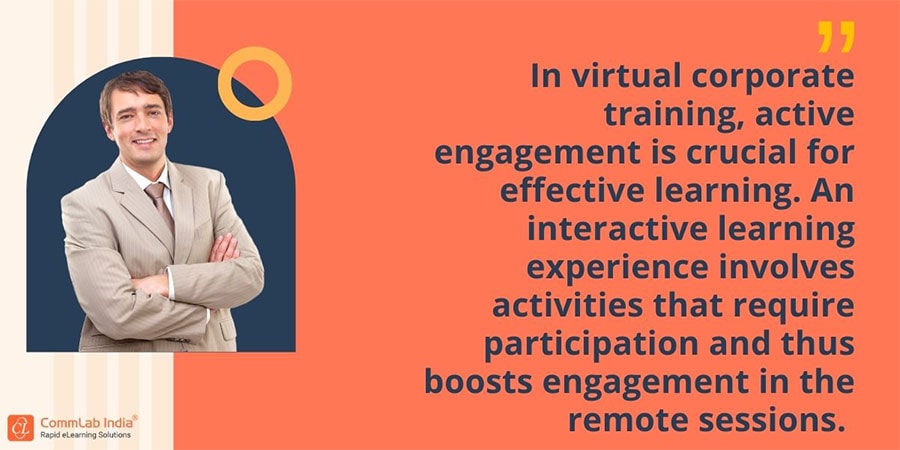6 Strategies to Keep Your Remote Learners Engaged in Virtual Training

Are your remote learners struggling to stay engaged during virtual training? In today's digital era, keeping participants focused and actively involved can be quite a challenge. But fret not! We've got you covered with six surefire strategies that will transform your virtual training sessions into captivating experiences.
But before that, let’s understand the importance of engaging remote learners. Virtual training offers many advantages, like flexibility, cost savings, and a global reach. However, it does present challenges, and one major hurdle is engaging remote learners.
Importance of Engaging Remote Learners in Virtual Training
Here are some reasons why engaging remote learners is essential in virtual training:
1. Promotes Active Learning: Active learning in corporate training requires remote employees to actively participate rather than passively consume information. Engaging them is key. Use tools like polls, quizzes, breakout rooms, and video-based learning scenarios to create an immersive learning experience, boosting engagement and knowledge retention.
2. Enhances Retention: Engagement increases the likelihood that learners will retain and apply the knowledge gained.
3. Improves Productivity: Actively engaged learners tend to be more productive in their roles, benefiting the organization.
4. Fosters Collaboration: Engagement can promote interaction and collaboration among remote learners, mirroring the teamwork often found in physical settings.
5. Ensures Training ROI: Effective engagement ensures that the organization's investment in virtual training yields the desired results and improvements.
→ Download Now: Interactive Templates for New-Age eLearning: Ready-to-Use in Articulate Storyline 360 [Ready-to-Use Templates]
These reasons are compelling for sure but how do you make your virtual training more engaging for your remote employees? Let's discuss
6 Strategies to Keep Your Remote Learners Engaged in Virtual Training
Strategy 1: Create an Interactive Learning Experience

Here's how to make your training more interactive:
1. Leverage Technology: Use polling software, whiteboards, breakout rooms, and online collaboration tools to engage participants in real-time.
2. Storytelling: Incorporate stories to make content relatable and emotionally engaging.
3. Encourage Discussion: Use chat features, breakout rooms, and online groups for post-session discussions and idea exchange.
4. Real-World Examples: Bridge theory and practice by using real-world examples and case studies during training.
An interactive learning experience enhances engagement and knowledge retention in virtual corporate training.
Strategy 2: Use Gamification Techniques
Gamification, a popular approach in corporate training, uses game-like elements to engage learners and drive them to achieve their goals. Here's how to apply it effectively:
1. Define Objectives: Before implementing gamification, establish clear learning objectives that align with your training goals. Tailor game elements to support these objectives, such as creating problem-solving challenges for skill improvement.
2. Points, Badges, Leaderboards: Incorporate game features like points for task completion, badges for achievements, and leaderboards to foster competition and motivate learners while providing instant feedback.
3. Interactivity: Move beyond game features by making the training experience more interactive and immersive.
Strategy 3: Incorporate Collaborative Activities
Collaboration is essential in any learning environment, including remote training. Incorporating collaborative activities fosters a sense of community among learners.
Try these strategies:

❝One key point to make a note of is to start with your collaborative learning activities with team-building icebreakers. These short and quick activities can help establish a welcoming learning environment.❞
Strategy 4: Provide Real-Life Examples and Scenarios
One of the most effective ways to keep remote learners engaged in virtual training is by incorporating real-life examples and scenarios into the learning experience. This strategy connects learning to the real world, encouraging critical thinking and catering to diverse learning styles, ultimately boosting information retention. By bridging the gap between the virtual and real, this approach makes the content relatable and practical, fostering active participation.
Strategy 5: Utilize Multimedia Tools for Engagement
Leveraging multimedia tools is a critical aspect of modern virtual training, enhancing learner engagement and interactivity. Visual aids, like images and videos, make content more digestible and boost retention. Incorporating quizzes, polls, games, and simulations encourages active participation and provides instant feedback. Multimedia elements, such as audio clips and podcasts, create a dynamic learning experience, offering convenience for busy remote learners. Additionally, these tools enhance accessibility and inclusivity, catering to diverse learning preferences.
Strategy 6: Encourage Self-Paced Learning and Reflection
In virtual training, self-pacing is crucial due to learners' diverse schedules and needs. This is also a great way to keep the learners engaged because catering to the learners’ preferences encourages them to do better.
Here's how to encourage self-paced learning:
1. Offer Pre-recorded Materials: Provide pre-recorded lectures or instructional videos for on-demand access. Learners can pause, rewind, or review sections as needed.
2. Supply Written Materials: Share handouts or slideshows to allow self-paced review.
3. Use Reflection Activities: Integrate reflection exercises like journaling prompts, discussion boards, or short quizzes to reinforce learning and let learners go at their own speed.
4. Embrace Interactivity: Incorporate interactive elements, such as gamification, simulations, etc.
Summing Up
Engagement is the key to effective virtual training for your remote employees. The six strategies discussed above offer actionable ways to make your virtual training more engaging and successful. By incorporating these elements, you create a dynamic learning experience for your remote learners, boosting their motivation and productivity.
Further, checkout these interactive templates from Articulate 360 to engage your remote learners in an immersive eLearning experience...




![How to Enhance Engagement with Articulate Storyline? [Infographic]](https://blog.commlabindia.com/hubfs/blogs/articulate-storyline-enhance-engagement-infog.jpg)
